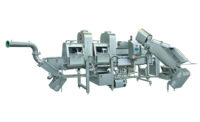
Chief Editor
On Jan. 1, 2004, Richard A. Graeter and two of his cousins, the brothers Robert and Chip Graeter, woke up as owners of Graeter’s Manufacturing Co. They bought the 140-year-old company from their aunt and fathers, who were the third generation to run the Cincinnati-based ice cream processor. The third generation maintained the quality of the product during its stewardship of the company. Now it was the fourth generation’s turn to make its own mark on the business.
What would they do? Should they build more company-owned scoop shops? Expand the franchising operation beyond Ohio and Kentucky? Develop (or drop) the bakery and confectionery business? Or venture far beyond their Cincinnati roots to new markets?
The Graeters considered all of those options. A series of management retreats and strategic planning sessions, facilitated by two outside consultants, led them to decisions that have placed the company’s super-premium, handmade ice cream in more than 4,000 grocery stores throughout the United States. But that didn’t happen overnight. It took hard work, money, confidence, strategic partners, a new manufacturing facility and the power of social media to bring the company to where it is today.
All of those factors have built Graeter’s annual sales to about $30 million. Ice cream accounts for roughly $26.3 million, bakery $3.5 million and candy $1.2 million.
Many cities have their signature foods - cheese steaks in Philadelphia, deep dish pizza in Chicago and sourdough bread in San Francisco. Cincinnati has a branded ice cream (Graeter’s) and chili (Skyline).
Graeter’s ice cream is part of the DNA of anyone who has lived in Cincinnati. Rich Graeter claims that his ice cream outsells Ben and Jerry’s and Häagen-Dazs combined in Cincinnati, the only place in the United States where that happens.
Whether by design or coincidence, the city is headquarters to quite a few retail businesses and consumer packaged goods companies; among the most notable: Procter & Gamble, Macy’s (formerly Federated Department Stores) and Kroger. Management trainees at these companies developed a fondness for Graeter’s ice cream, and as they were promoted and dispersed throughout the country, they kept a spot in their heart (but not their freezers) for the product. The same holds true for any number of alumni from the region’s colleges.
Ex-pats could satisfy their cravings only by returning to the Queen City or ordering the product from Graeter’s thriving mail-order business. The Graeters decided to tap this pent-up demand and grow the business by selling more ice cream in the Cincinnati region. The management retreats helped them reach that decision. It was the first of many steps that led eventually to national distribution.
At one of the first retreats, management consultants Paul Porcino and Robin Guiler charged the executives with the tasks of identifying the costs that went into manufacturing ice cream, baked goods and candies, and then allocating the costs to determine the profit margins in each line of business. This is pretty basic business school stuff, but the systems did not exist in the company at the time. The analysis showed:
• Company-owned stores had high sales but low profits.
• The ice cream division was subsidizing the bakery and confectionery product lines, which were unprofitable.
• The best growth opportunity was in ice cream sales to grocery stores, which had higher profit margins.

The decision to pursue the higher-margin grocery business meant the Graeters would have to make more ice cream. Porcino and Guiler told the Graeters that they could make more ice cream in the 75-year-old Reading Road facility if they improved their manufacturing processes.
“They either didn’t believe that was possible or didn’t trust us,” Porcino recalls. “In effect, they told us to prove it.”
Drawing on her background in manufacturing, Guiler began to tighten up the ship. She had the company set production goals, identify performance indicators and establish standards of conduct (including attendance). In effect, Graeter’s was remaking the culture at the Reading Road manufacturing facility.
“In six months, we stabilized daily production and increased it,” Porcino says. Output shot up by more than one third to almost 300,000 gallons annually. Graeter’s began producing more volume than it could sell. It needed more customers.
Kroger’s had been carrying the ice cream in its Cincinnati-area supermarkets. Rich Graeter said Kroger’s sales team told him that the shopper who has Graeter’s ice cream in her shopping cart is the grocer’s most valuable customer. In addition to appealing to upscale shoppers, the data also revealed that - paradoxically - Graeter’s appeals to women watching their waistline (the rationale being that after a strict diet and hard exercise, they have earned a reward and it’s going to be a satisfying, high-fat one.) Graeter also points out that he makes ice cream for adults, not for children (although Graeter’s lineup does include several kid-oriented flavors too, like the very popular Cookie Dough Chocolate Chip).
Graeter doesn’t remember who asked whom first, but following a fateful meeting with the Kroger sales team, the decision was made to test Graeter’s in a new market. Because of its high index for super-premium ice cream, Denver (where the chain is known as King Soopers) was chosen. Graeter’s passed the test. Next up was Kroger’s Texas division with stores in Houston and Dallas. The Atlanta division was the following year. Based on the successes in these markets, the Kroger team was ready to take Graeter’s to its remaining divisions (nearly 2,400 stores).
With the national distribution deal in hand, Graeter’s now had to fulfill its commitments to its most valuable customer. It had to be able to ship enough ice cream to satisfy the needs of Kroger’s stores nationwide. But production wasn’t the only problem. While the plant could handle the increased demand (Porcino says the Reading Road plant could probably make 500,000 gallons annually; Rich Graeter figures the output much lower), there was simply no space to store the finished ice cream. Freezer space was the constraining issue; the number of pallet spaces it had was zero. Pints were packed in cardboard boxes and hand carried into the freezer (the forklift would not fit through the door). Pints had to be sent to another local ice cream company to be repacked into cartons, palletized and then stored. There was simply no room in the old plant to package and store the finished product. If Graeter’s was going to expand, it needed a new plant with space to package and store its ice cream.
So Rich Graeter went looking for a new location and the financing to build a new facility. After looking at sites in Kentucky and Indiana, Graeter struck a deal with the city of Cincinnati to build a new plant from the ground up on vacant city property, financed by a $10 million municipal bond package. (See Graeter’s Runs a Hands-on Ice Cream Plant on page 36.) Graeter called that move “audacious” and “scary.”
Porcino says the expansion was a bit of good news in an otherwise bleak economy. The Graeters created jobs for hundreds of construction workers and added about 60 manufacturing jobs once the plant opened in June 2010.
Having secured shelf space in Kroger stores, Graeter’s sought more new customers so that the investment in the new plant would pay off. VP of sales and marketing George Denman says he is now “filling in the holes” and focusing on upscale grocers, like Sunset Foods in Chicago’s pricey North Shore suburbs.
Sunset co-owner John Cortesi learned of the brand from a sister who lives in Cincinnati. He wanted to be the first grocer in Chicago to carry Graeter’s ice cream. Sunset Foods promotes it with in-store sampling, signage and prominent display on weekly circulars. Cortesi says he expects the ice cream to do well during the holidays.
“We love it,” he says. “Our customers are well-traveled and they gravitate to it.”

When Rich Graeter worked for his father (Dick), the two didn’t always agree on the strategic vision for the company. Author Robin Davis Heigel documents the friction in her book, “Graeter’s Ice Cream: An Irresistible History.” Rich has his own way of managing. He is a fan of Jim Collins’ business books, including “Good to Great” and “Built to Last.”
Collins’ Hedgehog Concept refers to a product that a company is passionate about, which ultimately leads the company to outshine its competitors. The mission of Graeter’s is “to make the best ice cream you ever tasted,” says Graeter. When Collins writes of “clock building,” he refers to building a core value system and creating a company that can prosper beyond the presence of any single leader and through multiple product life cycles.
Rich Graeter talks about keeping the business “forever,” by which he means that the Graeters do not want to sell the business. They want to keep it in the family. Graeter and his cousins are out to make sure that happens.
The company’s growth has consisted of more than building a plant and expanding production. It created the imperative to bring in high-level executives who can achieve the goals the board has set. Graeter’s saw the need to add a chief financial officer, a controller, a vice president of manufacturing, a vice president of sales and marketing and a vice president for retail to oversee the Columbus and Dayton markets.
Graeter says his managing philosophy is: Hire good employees and let them lead. He says he believes in autonomy for employees. Managers are considered part of the executive team and are invited to weekly Monday meetings. When they can, the Graeters promote from within and give the employee the necessary training.
An efficient marketer
Despite being a national brand, Rich Graeter acknowledges that his company is still a relatively small player with limited means. So the company has to be creative and strategic in its marketing and advertising.
Word-of-mouth, direct mail, public relations, appeals to bloggers and social media campaigns, along with limited advertising keep the brand in front of the public. Graeter’s and Facebook seem to be made for each other. The social medium allows Graeter’s ice cream fans to connect and share their love for the product. In late July, the company had more than 130,000 “likes.” (By comparison, Ben and Jerry’s had 3 million and Häagen-Dazs 574,000.) Graeter’s taps into 150,000 names developed from its mail order business. And creative marketing, such as sponsoring alumni meetings in exchange for email addresses, helps the company leverage its reach.
Spontaneous mentions on television, such as those by actress Susan Lucci on the Nate Berkus show and by Oprah Winfrey herself, led to spikes in the mail order business. Mentions of the ice cream turn up in unlikely places. Author James Patterson has a character who speaks of Graeter’s in his book “Honeymoon.”
The company samples ice cream at special events, such as the Taste of Cincinnati, where staff distributes individual serving-size cups of ice cream. Besides building goodwill in the community, these events give the company information about flavors and preferences. Based on 5,000 samples of green mint and white mint ice cream, Graeter’s went with the “white mint” version of its traditional Mint Chocolate Chip because the tasters could not tell the difference in flavor and preferred an all-natural product to one with artificial coloring.
Although they now play on a national stage, the Graeters stay connected to the Cincinnati community. Graeter’s is a major sponsor of The Cure Starts Now Foundation, which is working to find a cure for pediatric brain cancer, and The Rusty Ball, which is an annual event that in 2010 raised more than $300,000 for local charities. Additionally, Rich Graeter was chairman of the board of Cincinnati Public Radio, his wife served as president of the Greater Cincinnati Alzheimer’s Association and his cousin Chip was chairman of the local Boy Scouts of America’s annual campaign.
“Community involvement is just part of being a good corporate citizen” says Graeter says. “These are our neighbors; it’s not a marketing ploy.”
The next steps
One thing that wasn’t on the strategic plan the company developed at its management retreats was getting out of the franchise business. That happened suddenly in 2010 around the time they were cutting the ribbon to open their new plant. Unexpectedly, their largest franchisee, which operated 15 stores in Columbus and Dayton, decided to cash in on Graeter’s success by selling their franchise to a third party. Not wanting to lose further control of an important market in their home state, the Graeters decided to buy back the units themselves. A few months later, the company reacquired the franchises in northern Kentucky, and almost overnight, Graeter’s storefront business doubled.
Porcino says by that time the Graeters had enough confidence in their abilities not to be thrown off course by these acquisitions.
Chip Graeter manages the retail business. This year he is overseeing the construction of two newly designed stores that are intended to be prototypes for the future. The stores are trimmed in dark woodwork, have tiled floors and sleek, glass cases showcasing baked goods and ice creams. Customers come for ice cream cones, sundaes, pints and 56-ounce packages of ice cream, a novelty chocolate chip ice cream sandwich called a Chip Wheelie, candies, cakes and pies. The stores also sell gifts (geared toward grandparents buying for grandchildren) and greeting cards.
Graeter created a guest service model, which teaches employees to greet and acknowledge guests cheerfully and to engage them while in the store. The idea is to elevate the experience of buying ice cream to entertainment. Every store is shopped by two Graeter’s managers and two mystery shoppers every month.
Graeter managed the installation of a new point-of-sale system that will help the company track sales in more detail (and in a more timely fashion) and manage its Sweet Rewards loyalty program. Decisions now are more data-driven than seat-of-the-pants gut feelings.
Since Graeter’s had always thought of itself as a small company, it kept to itself. These days, it needs to go out and meet buyers at tradeshows and mingle with its peers at industry gatherings.
“We are more visible now,” says Chip’s brother Bob, who runs the manufacturing end of the business.
Graeter’s joined trade groups, including the International Dairy Foods Association, the National Frozen and Refrigerated Foods Association and the National Association of Specialty Food Retailers. It is also a member of the All Star Dairy Association, the Lexington, Ky.-based buying group.
The fourth generation acknowledges the contributions the previous managers made to the company. Louis Charles Graeter started making ice cream in Cincinnati in the 1880s. His third wife, Regina, took over the business in 1919 when Graeter was struck and killed by a car as he was crossing the street. The second generation expanded in the bakery business. Rich Graeter’s father, uncles and aunt expanded the scoop shops and entered the grocery business.
In Heigel’s history of the company, Rich Graeter says of his great-grandmother, Regina, “without her strength, fortitude and foresight, there would be no Graeter’s Ice Cream today.” He honored the woman he never met by re-naming East 66th Street in front of the new factory, Regina Graeter Way.
The Scoop on Graeter’s
• Founded in Cincinnati in 1870 by Louis and Regina Graeter.
• Produces ice cream with the French pot method, which is similar to using a hand-cranked maker.
• Pints and 56-ounce packages are hand-packed.
• Sells nine original flavors: black cherry, butter pecan, caramel, chocolate, coffee, cookies and cream, Elena’s blueberry pie, strawberry and vanilla.
• Elena’s Blueberry Pie ice cream was created by a Graeter’s customer to honor Elena Desserich and to benefit The Cure Starts Now Foundation, a Cincinnati-based non-profit organization whose mission is to educate, aid and fund the research for a cure for pediatric brain cancer. Elena died at age 6 of brain cancer.
• Sells 11 “signature chip” flavors, including black raspberry chip, coconut chip, mint chocolate chip and toffee chip.
• Makes three sorbets: lemon, raspberry and strawberry
• Gives a free Frosty Paw treat to dogs who visit a Graeter’s retail store on the first Tuesday of every month.
The Keys To Continued Success
Robin Guiler and Paul Porcino consulted with Graeter’s management, helping it identify strengths, opportunities and gaps. The keys to Graeter’s continued success, Porcino says, will be:
• Commitment to the customer (grocery stores). Graeter’s has to keep its customers’ confidence by demonstrating that it can supply product on time.
• Competition. Since expanding beyond Cincinnati, competitors have cut prices severely. “Be cognizant of the competition,” Porcino says.
• Manage production and inventory.
• Build the logistics system. Get the product from the plant to the customer in the most efficient manner.
To this advice, CEO Richard Graeter adds, “Maintain our fanatical devotion to product quality.”


